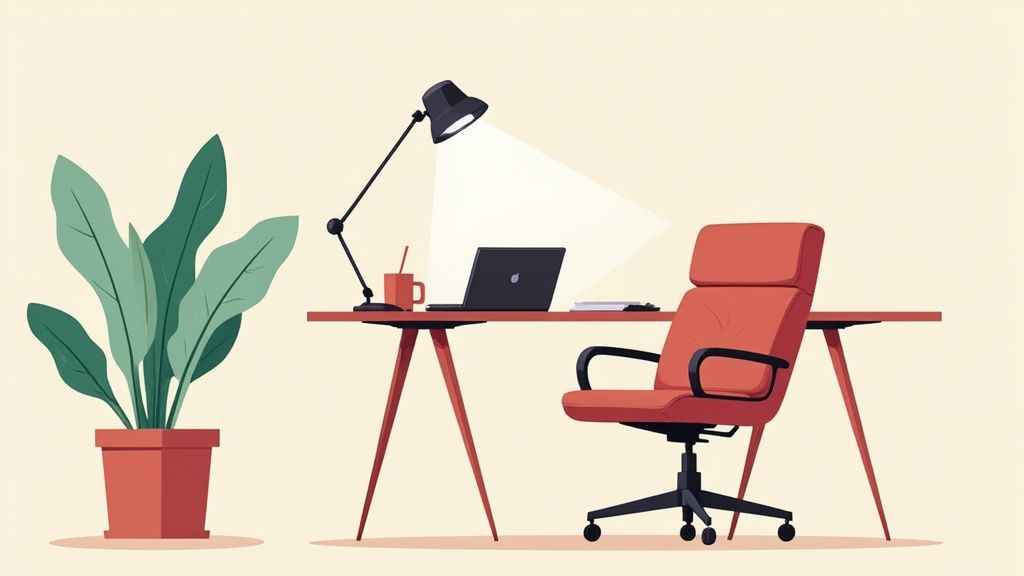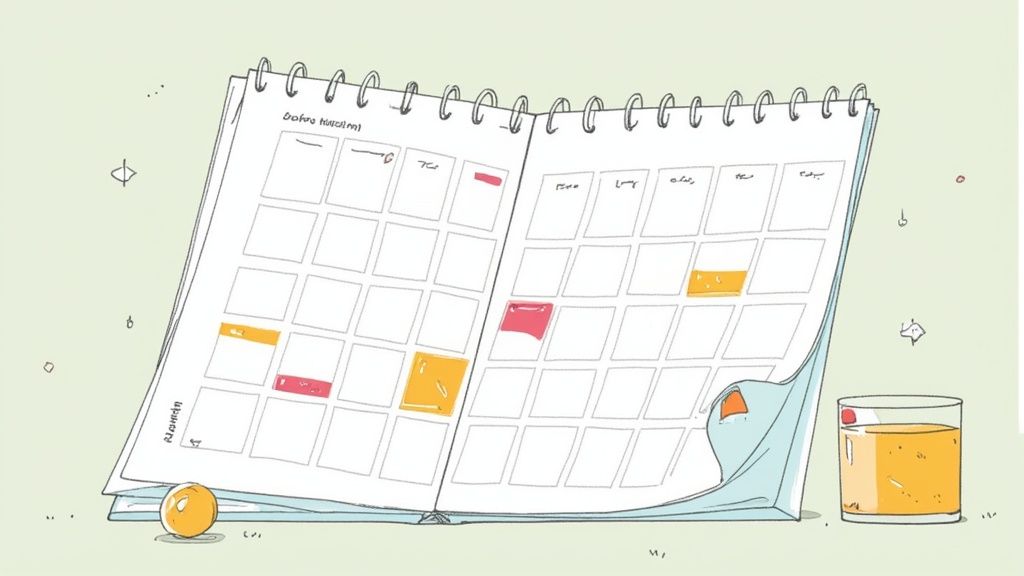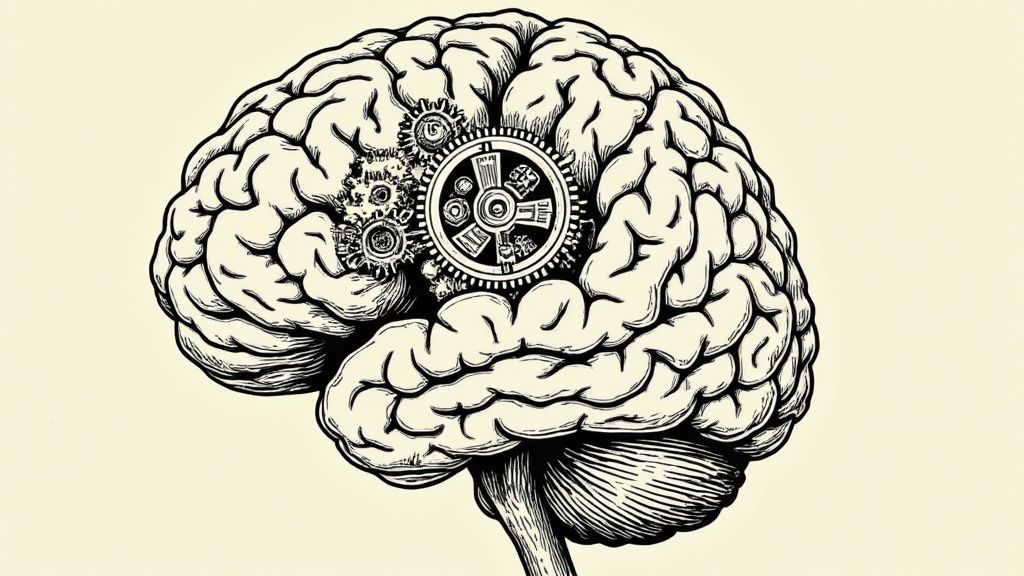How to Improve Focus at Work: Expert Strategies That Transform Productivity
Understanding the Hidden Cost of Lost Focus

Being constantly interrupted at work does more than just annoy us - it seriously impacts our ability to do meaningful work. Every notification, message, and quick question fragments our attention and makes it harder to stay focused on important tasks. To improve how we work, we first need to understand just how much these interruptions really cost us.
The Price of Interruption
That quick glance at your phone isn't just a few seconds lost. Research shows that even brief distractions can completely derail your concentration, requiring up to 23 minutes to fully refocus afterward. Simple interruptions like checking a text or answering a coworker's question add up fast - the average professional loses about three hours each day to disrupted focus. Think about what you could accomplish with three extra hours of concentrated work time.
Quantifying the Challenge
Smart teams don't just accept scattered focus as inevitable. Many are now tracking interruptions and measuring their impact on productivity to identify patterns and biggest focus drains. Some use time tracking tools to monitor task duration and interruption frequency. This data helps them develop targeted strategies for protecting focused work time.
The Multitasking Myth
While some consider multitasking a valuable skill, science shows our brains can't effectively handle multiple complex tasks at once. Instead of true multitasking, we rapidly switch between activities, paying a mental "switching cost" each time. This constant context-switching drains our mental energy, leads to more mistakes, and reduces overall output. That's why focusing on one thing at a time is crucial for productivity.
Assessing Your Focus Patterns
The first step to better focus is understanding your own patterns. Start tracking when and how often you get interrupted, what typically distracts you, and how long it takes to regain concentration. By identifying your specific focus challenges, you can develop personalized solutions. For example, if email notifications frequently break your focus, try turning them off during deep work periods. If you concentrate best in the morning, schedule your most demanding tasks then. Recognizing these patterns helps you protect your focus and get more done.
Creating Your Personal Focus Sanctuary
Good focus is essential for getting meaningful work done. But in today's workplace filled with notifications, messages, and constant interruptions, finding that focus can feel impossible. The solution is to build your own focus sanctuary - a thoughtfully designed workspace that helps you concentrate deeply on what matters most.
Optimizing Your Physical Workspace
Your physical environment has a direct impact on your ability to focus. Think about your desk area like an ecosystem - everything around you either supports or disrupts your concentration. A messy, cluttered desk often leads to scattered thinking, while a clean, organized space helps create mental clarity and calm. Start by clearing unnecessary items and arranging your tools in a way that supports smooth workflows.
Physical comfort also plays a key role. Position your desk near natural light to boost alertness and mood. If you work in a noisy area, consider using noise-canceling headphones or a white noise machine to create a more peaceful atmosphere. Pay attention to ergonomics too - adjust your chair height and monitor position to prevent physical strain that can break your focus. These small changes add up to make a big difference in your ability to concentrate throughout the day.
Taming Your Digital Environment
Just like physical clutter can derail focus, a chaotic digital workspace makes it hard to think clearly and work deeply. The endless stream of notifications, emails and messages constantly fragments our attention. Taking control of your digital environment is crucial for maintaining focus.
One effective approach is "digital minimalism" - being selective about which tools and platforms you allow into your workday. Turn off non-essential notifications during focused work periods. Process emails and messages in batches at set times rather than constantly checking them. Remove distracting apps from your phone and computer. Creating a calmer digital space helps your mind settle into deep work more easily.
Establishing Boundaries and Routines
Your focus sanctuary needs clear boundaries to be effective. Let colleagues and family know when you need uninterrupted work time. Block out "focus periods" in your calendar and communicate their importance. This helps manage expectations and prevents unnecessary interruptions during your most productive hours.
Consistent daily routines are also key for training your brain to focus deeply. Set regular work hours, take planned breaks, and maintain a steady sleep schedule. Just as athletes follow specific training regimens, you can develop routines that optimize your mental performance. When you stick to these patterns, your mind learns to naturally enter a state of concentration.

Building your personal focus sanctuary takes time and ongoing effort. But by thoughtfully shaping both your physical and digital environments while establishing strong boundaries and routines, you create the conditions for sustained concentration and deep work. These changes lay the groundwork for the next challenge: managing the constant flow of digital information.
Mastering the Digital Deluge

Even with a dedicated focus space, managing the constant flow of digital information remains a key challenge of modern work. The steady stream of emails, messages, and alerts can quickly erode your concentration. To truly improve focus at work, you need effective strategies for handling this continuous influx while maintaining deep focus.
Taming the Notification Beast
Consider how a chef would struggle to prepare an intricate dish while being interrupted every few minutes with requests for different ingredients. Just like that chef, our brains cannot maintain focus when constantly pulled away by notifications. Research shows that 80% of employees face distractions at least once per hour, with notifications being a major cause. The solution? Turn off non-essential notifications during focused work periods - this means muting social media, news alerts, and even some email notifications. By creating periods of notification silence, you give your brain the space it needs to fully engage with important tasks.
Batching Communications for Deeper Work
Checking messages throughout the day creates a scattered workflow that prevents deep focus. A better approach is to batch your communications into specific time blocks. Set aside 30-minute periods in the morning, afternoon, and late afternoon solely for handling emails and messages. Think of it like a librarian organizing books - rather than shelving each one as it arrives, they gather them in batches to shelve all at once. This focused approach allows for longer periods of uninterrupted work while still staying responsive to important communications.
Strategic Communication Protocols
Clear team communication guidelines can significantly reduce unnecessary interruptions. Work with your team to establish agreed-upon channels and timing for different types of communication. Use direct messaging or calls for truly urgent matters, but route non-urgent items through email or project management tools. Set realistic expectations around response times so team members don't feel pressured to immediately answer every message. These protocols create more predictable communication patterns that support focused work while maintaining effective collaboration.
By putting these approaches into practice, you can turn the digital flow from a constant distraction into a manageable part of your workday. Not only will this boost your personal focus, but it helps create a more productive environment for the whole team. With these foundations in place, you'll be ready to explore how technology can actively support rather than hinder your focus - which we'll cover in the next section.
Making Technology Work For Your Focus

Technology often gets blamed for destroying our focus at work. But when used thoughtfully, it can actually help us stay on track. The key is choosing and using digital tools intentionally to minimize distractions and support deep work.
Smart Automation for Better Focus
Think of smart automation like having a personal assistant who handles routine tasks so you can focus on what matters most. Setting up email filters lets you process messages in batches rather than constantly checking your inbox. Using workflow tools to streamline repetitive tasks like data entry or report generation frees up mental space for more demanding work. By automating these small but necessary tasks, you can maintain focus on your priorities.
Tools That Support Concentration
Several apps and tools can actively help protect your focus. Website blockers prevent access to distracting sites during work periods. Focus timers, like those based on the Pomodoro Technique, guide you through focused work sessions followed by short breaks. Movement break apps like Moova help you take quick activity breaks to refresh your mind and body. These tools create an environment that makes it easier to stay on task.
Taking Control of Notifications
Random notifications can derail even our best attempts to focus. The solution is being proactive about managing them. Turn off non-essential notifications during focused work sessions. Set specific times to check and respond to messages in batches. Create notification priority levels so truly urgent matters get through while less important updates wait. This puts you back in control of when and how you process information.
Building Mindful Tech Habits
The real key to making technology support focus is developing mindful habits around how we use it. Schedule specific times for email and messaging rather than checking constantly. Create tech-free zones or times in your workspace. Pay attention to which apps and notifications actually help versus hinder your work. Small changes in how you engage with technology can have a big impact on your ability to focus throughout the day.
Building Your Focus Recovery System
Getting interrupted at work is unavoidable. The real skill isn't avoiding distractions completely but knowing how to get back on track quickly when they happen. Just like a tennis player who loses a point but immediately resets for the next serve, we need systems to help us bounce back from disruptions and maintain our productivity throughout the day.
Mental Reset: Clearing the Interruption Debris
After someone interrupts your work, your mind often feels scattered - like a messy desk with papers everywhere. The key is doing a quick mental reset. Try the "brain dump" technique: Take 60 seconds to write down any lingering thoughts, tasks, or concerns swirling in your head. For example, if a coworker asks about another project while you're deep in a task, jot down any related ideas before returning to your original work. This prevents those random thoughts from nagging at your attention later.
Attention Training: Strengthening Your Focus Muscle
Your ability to focus improves with practice, much like building physical strength at the gym. Short mindfulness meditation sessions are particularly effective - even 5-10 minutes daily helps you better resist distractions and maintain concentration. This works by building up your prefrontal cortex, the brain region that manages focus and attention. Another helpful approach is deliberately practicing "single-tasking" - giving one activity your complete attention rather than multitasking. This means staying fully present whether you're reading an email or having a conversation.
Energy Management: Fueling Your Focus
Focus requires mental energy, and like a car running on empty, your concentration drops when you're depleted. Taking strategic breaks helps recharge this energy. The Pomodoro Technique of working in 25-minute intervals followed by short rests can work well. Use these breaks to actively recharge - take a brief walk, do some stretches, or practice deep breathing. Avoid looking at screens during breaks since that often drains mental energy further. Save the social media and web browsing for longer breaks.
Tailoring Your System: Different Interruptions, Different Strategies
Each type of interruption needs its own recovery approach. A quick question requires a different response than an hour-long meeting that breaks your flow. Create specific strategies for different scenarios. Minor distractions might just need a 30-second mental reset, while major interruptions call for a longer break plus an energy-boosting activity. This personalized system ensures you can effectively recover and refocus based on the specific disruption you face.
Sustaining Long-Term Focus Excellence
Building focus is only the first step - keeping it strong over time requires commitment and smart strategies. Rather than chasing quick fixes, you need sustainable habits that grow with you and systems that support ongoing improvement.
Measuring and Tracking Your Focus Improvements
To improve your focus, start by understanding where you are now. Track key metrics like how often you get distracted and how long it takes to refocus. Use a simple spreadsheet to record this data - it will show you what's working and what isn't. For instance, you might notice a big drop in interruptions after turning off notifications. Making decisions based on data helps you find what truly works for your focus.
Adapting and Refining Your Focus Strategies
Good focus habits need regular updates as your work changes. When you take on more team projects, your deep work schedule might need adjusting. You could block out specific collaboration times while keeping focused solo work periods. Review your strategies monthly - what's helping you focus and what needs to change? Like tending a garden, your focus practices need ongoing care to stay healthy.
Celebrating Wins and Maintaining Motivation
Notice and celebrate your focus wins, even small ones. Did you finish a complex task without getting distracted? Did you successfully try a new focus technique? Take a moment to acknowledge these achievements. Maybe share them with a colleague or give yourself a small reward. Connect better focus to your bigger career goals - how will it help you succeed? This bigger picture helps maintain your drive to keep building strong focus habits.
Building a System for Long-Term Success
Don't rely only on willpower - create systems that naturally support good focus. Add focus practices to your daily schedule, make checklists for your focus environment, and use tools to handle distracting tasks automatically. For example, schedule daily meditation, set up email filters, or use website blockers during deep work. Having these systems removes the constant need for motivation and creates an environment where focus comes more naturally.
To boost your focus while staying active during work, try Moova - a mobile app that guides you through quick 3-minute exercise breaks. These mini-workouts help fight fatigue, stiffness and poor posture that can derail your focus. Learn more about how Moova can improve your workday wellbeing and focus.







